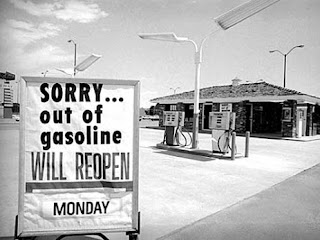The United States has faced a series of major economic issues in its history, the two most commonly discussed are the Great Depression (1929 to 1942 arguably) and the Great Recession (2008 – 2009 officially) but between those two is a lumpy, difficult to fathom, general economic decline that ran from 1971 until roughly 1982 which could be considered the Great Stagflation. It was the hallmark of the 1970s United States economy, with a solid impact on the British economy as well. Within the United States it was caused by an intersection of several different policy issues, economic impacts, and major events, such as the two oil shocks that took place in that decade as OPEC reduced oil production in response to the United States’ position towards Israel.
Nixon, who had a very loose concern for domestic economic issues, made the problems worse when facing the gold crisis of 1971. Briefly the United States pegged the dollar to a fixed conversion rate and other currencies were fixed to the United States dollar. During the early 1970s the dollar ended up being worth less in actual goods and services than its fixed gold value, leading to other nations beginning to convert their dollar holdings into gold. Nixon nipped that problem by simply ending the gold conversion of dollars “temporarily” and then imposing price controls to take the sting out of the sudden devaluing of the United States dollar as foreign governments dumped their now non-convertible dollars. This was fine for Nixon, he was facing re-election in 1972 and he simply wanted domestic voters to feel that their paychecks remained the same, it didn’t matter to him what happened to the economy post-1972 as much, he simply planed to fix it then.
One of the impacts of this, and other factors such as rising foreign competition that cut the United States share of global trade, spiked inflation rates. This combined though with an unusual factor, as rising inflation eroded the buying power of domestic wages in the United States, organized labor was powerful enough to demand wage increases from companies to offset the inflation. This reduced the amount of capital available for investment and the economic instability and uncertainty that rising inflation caused discouraged many businesses from entering into any major investments. This led to economic stagnation, the production of goods and services simply didn’t expand to meet the growing money supply, which caused shocking inflation rates. (During the height of the crisis inflation rates of 10% were not uncommon in a single year.)
Normally economic cycles tweak the system, but the events of the 1970s reshaped the United States economic and political landscape. First, rising inflation pushed up the tax brackets which working and middle class employees were taxed at, as the brackets were not indexed in the 1970s to inflation. So although the relative buying power of a paycheck remained the same, the bite taken out by state and local taxes went up for many workers, reducing their overall net pay. This combined with many states reporting record surpluses due to the revenues taken in, and a resistance by those state governments to return the surpluses to the voters. (California was notorious for this, socking away much of the surplus for future anticipated shortfalls or new programs once the economy settled down.) Property taxes shot up as well, as the paper value of homes skyrocketed due to inflation and people saw their property tax bills rocket upwards, further reducing their buying power.
The result was a general tax revolt across the United States as citizens, in state elections and in 1980 with the election of Ronald Reagan and a Republican Congress, demanded their tax burden be lowered. What made this shift particularly unique though was that prior to the late 1970s and early 1980s the United States populous had been less leery of inflation, and higher taxes, and more leery of the government reducing its safety nets. By the height of this crisis the United States citizenry had changed their demands, inflation control and lower taxes were more critical to them than safety nets, especially safety nets that seemed to re-route funds from middle class pockets to the poor, minorities, and immigrants.
Which state governments, and the federal government, responded to with great gusto. The federal government, and state governments, slashed social welfare programs aggressively and changed the regulatory client to make the government more pro-business. This combined with a focused effort to reduce the power of organized labor and allowing unemployment to spike, and a sharp early 1980s recession, to crush inflation. In many ways since then the United States as a nation has not looked back, and other nations have followed its model, focusing on tight government services, reduced social support for the lowest portions of society, and keeping the tax burden controlled.
Sources: Wikipedia articles on stagflation, the Nixon Shock, and the 1973-1975 recession, Investopedia article on the Great Inflation of the 1970s, Dollars and Sense article on the 1970s economic crisis, and chapters from The Seventies: The Great Shift in American Culture, Society, and Politics by Bruce J. Schulman







